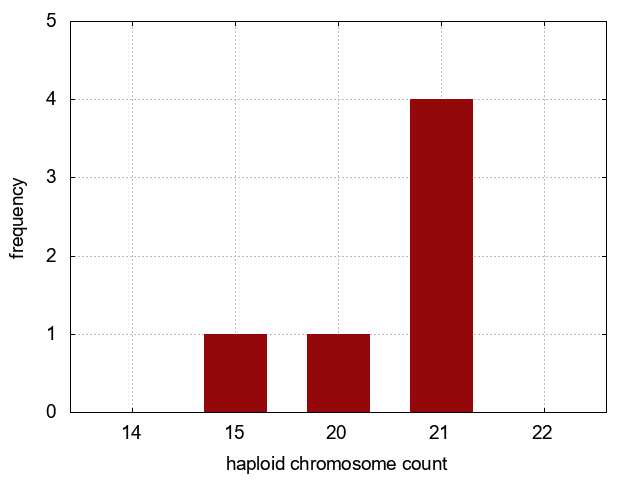Euglossini
Cytogenetic data
| Species | Sample local | Country(ies) | Haploid(n) | Diploid(2n) | Karyotype | Notes | Genome size (pg) | Classic cytogenetic data | Molecular cytogenetic data | References |
|---|---|---|---|---|---|---|---|---|---|---|
| Eufriesea violacea | Viçosa, Minas Gerais | Brazil | 15 | 30 | 2k= 30submetacentric | C-banding, G-banding | Gomes et al. 1998 | |||
| Euglossa cordata | Cataguases, Minas Gerais | Brazil | 21 | 42 | 2k= 42submetacentric | as Euglossa carolina | C-banding | DAPI/CMA3 | Fernandes et al. 2013a | |
| Euglossa cyanaspis | Panama City | Panama | 21 | k= 21submetacentric | Eltz et al. 1997 | |||||
| Euglossa hyacinthina | Province Chiriqui | Panama | 20 | 40 | k= 20submetacentric | Eltz et al. 1997 | ||||
| Euglossa sp. | Viçosa, Minas Gerais | Brazil | 21 | Ag-NOR | Maffei et al. 2001 | |||||
| Euglossa townsendi | Viçosa, Minas Gerais | Brazil | 21 | 42 | 2k= 42submetacentric | C-banding, G-banding | DAPI/CMA3 | Fernandes et al. 2013a |
Chromosome classification: Levan et al. (1964): metacentric (m), submetacentric (sm), subtelocentric (st), or acrocentric (a). Imai (1991): metacentric (M) or acrocentric (A), with a variety of forms depending on the position of the heterochromatin on the karyotype.
You can download this data as csv.
Histogram

Bibliography
Gomes, L.F., Brito, R.M., Pompolo, S.G., Campos, L.A.O., Peruquetti, R.C. Karyotype and C-and G-banding patterns of Eufriesea violacea (Hymenoptera, Apidae, Euglossinae). Hereditas, 128 : pp 73-76. 1998. DOI: [10.1111/j.1601-5223.1998.00073.x https://doi.org/10.1111/j.1601-5223.1998.00073.x]
Eltz, T., Schmid, M., Roubik, D.W. Haploid karyotypes of two species of orchid bees (Hymenoptera: Apidae, Euglossini). Journal of the Kansas Entomological Society, 70 : pp 142144. 1997
Fernandes, A., Werneck, H.A., Pompolo, S.G., Lopes, D.M. Evidence of separate karyotype evolutionary pathway in Euglossa orchid bees by cytogenetic analyses. Anais da Academia Brasileira de Ciências, 85 : pp 937-944. 2013a. DOI: [10.1590/S0001-37652013005000050 https://doi.org/10.1590/S0001-37652013005000050]
Maffei, E.M.D., Pompolo, S.G., Silva-Jr, J.C., Caixeiro, A.P.A., Rocha, M.P., Dergam, J.A. Silver staining of nucleolar organizer regions (NORs) in some species of Hymenoptera (bees and parasitic wasps) and Coleoptera (lady beetle). Cytobios, 104 : pp 119-125. 2001
